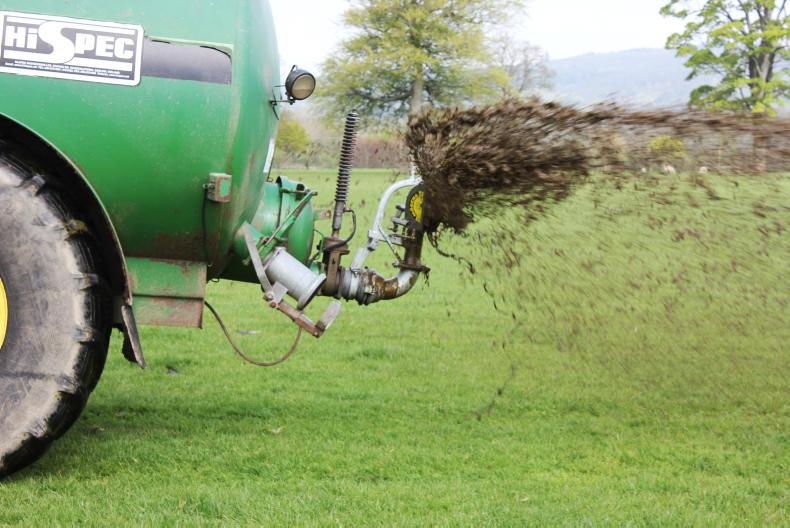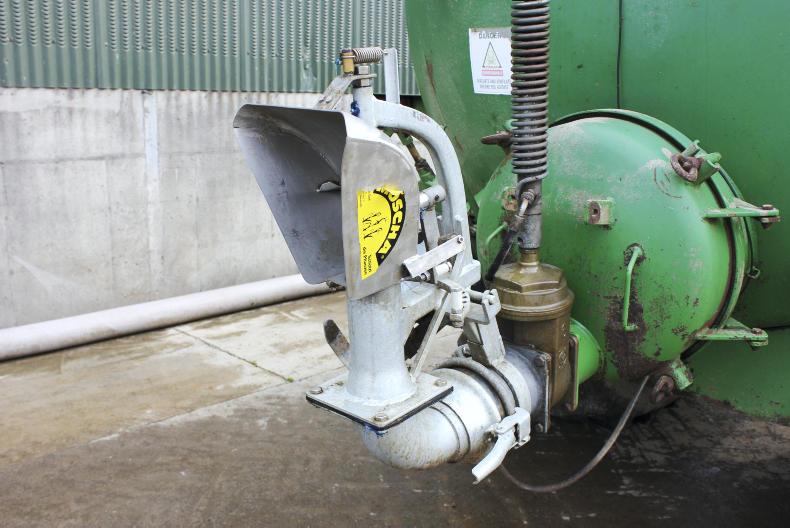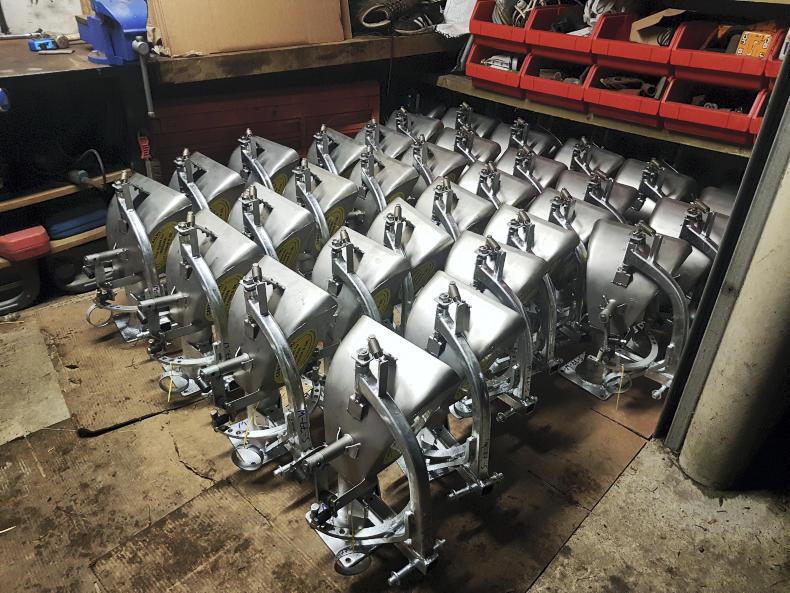Back in 2013, Dermot Tobin went to Agrictechnica to see if there was anything that stood out as impressive.
As soon as he saw the Moscha swivel spreader, he knew there was something to it. In January 2014, Dermot took delivery of a unit, the first of many.
How does it work?
The swivel spreader works on the principle that the flow of slurry flicks the spout from side to side but the ingenious inner diverter plate means that as the spout gets to either side of the arc, the flow of slurry also cushions the change of direction.

The Moscha swivel slurry spreader attachment is bolted on to the rear of a slurry tanker with a special clamp system. It has a 12m bout spreading width of slurry droplets that are larger and create less smell than those from a conventional splash plate system.
One of the main advantages of the Moscha is the fact that the slurry is leaving the spreader at a far lower velocity than from a splash plate system.
This allows the slurry to form large droplets rather than a spray pattern.
These large droplets are claimed to have numerous advantages ranging from smell reduction and better utilisation of the nitrogen in the slurry to reducing the chances of water pollution in comparison to both splash plate and trailing shoe systems.
From the point of view of odour reduction, I personally noticed a serious improvement in the strength of the smell in comparison to a splash plate.
Dermot claims that the spread pattern bring many advantages over the other systems on the market.
He and other users say that animals can be left out to spread ground far quicker than after a splash plate application, anything from a couple of days earlier up to a week in some cases.
This is due to the spread pattern of the Moscha which spreads over a large area. Instead of covering the entire leaf and plant area, the larger droplets pass through the growing grass crop straight to the ground.
This causes less souring of the grass and makes it more palatable for following animals. The larger droplets also protect the nutrients in the slurry and give you better value from the valuable resource that is slurry.
Fitting a unit to your tanker
The Moscha can be fitted to any make or size of tanker, from the big 6,000-gallon monsters to a 600-gallon tank for watering a large garden.
Dermot has sold machines to people from all ends of this market and, having talked to many of his customers, the swivel spout is doing the business for them. The fitting process is very simple and, once the spreader arrives with its new owner, fitting is only a matter of taking off the previous attachment and bolting on the Moscha.

A close-up of the Moscha spreader unit, which is made from stainless steel and supported on a galvanised structure that fits to all makes of slurry tanker.
Dermot is always on the end of the phone if guidance is needed.
Each spreader is supplied with the correct adaptor plate and coupling for the make and model of tanker it is ordered for.
Orders are dispatched once payment has cleared and next day is possible in Ireland and three days is the norm to the UK. Having seen the original spreader that Dermot took delivery of in 2014, it is still working on his home farm.
There are very few moving parts in the system. Maintenance of the swivel spreader is simple. There are three grease nipples that should be greased every day before work begins. If this is done, the system will be good for 5m to 6m gallons of slurry before a service kit is required to replace any of the wearing parts in the spreader. This service kit is available for €35 plus Vat and next-day delivery.
Environmental and compaction advantage
There are many advantages to the Moscha, according to Dermot Tobin. A drop in air pollution is the first one that I noticed with a reduction in smell and the larger droplets left less surface area for pollutants to enter the air during flight.
Once on the ground, the pattern of the spread which had been checked using a tray test shows that it is perfectly even over the full range spread width, which can reach an impressive 18m.
This even spreading means that no area of the ground becomes saturated with slurry, allowing for both a better uptake of the nutrient into the plant and less chance of water contamination as all the nutrients are being used. This differs from all other spreading methods as none of them can spread as evenly as the swivel spout.
Power
The power requirement for one of these systems is much lower than that required for a trailing shoe system. It has a twofold advantage, in that the cost of the tractor is much less and it is light, meaning that there is far less compaction.
While on compaction, the width of the spread from the Moscha also means that fewer trips are required to cover the ground with a smaller tractor.
Every operator I spoke to said that their output had improved drastically since they fitted the swivel spout.
This was due to different factors including the spread width and also the ability of the Moscha to spread slurry of the same consistency as a splash plate but with a reduction in blockages of between 30% and 40%.

The Moscha comes in different sizes depending on the pump capacity of your spreader or umbilical system.
Prices range from €975 plus VAT to €1,125 plus VAT for single-spout spreaders.
There is also a twin-spout option, which can be a pair of any of the available spouts on a T-bar allowing an even wider spread width. These start from €3,200 plus VAT.
You can purchase a larger spout than you need currently and a tap-in insert can be supplied and removed if a larger-capacity pump is used at a later date.
This means that there is no need to upgrade your spout if you upgrade your tanker. A full range of Moscha spreaders will be on display on the Castle Agri stand at Ploughing 2017.
Read more
Everything you need to know about Ploughing 2017
Splash plate ban looms
Back in 2013, Dermot Tobin went to Agrictechnica to see if there was anything that stood out as impressive.
As soon as he saw the Moscha swivel spreader, he knew there was something to it. In January 2014, Dermot took delivery of a unit, the first of many.
How does it work?
The swivel spreader works on the principle that the flow of slurry flicks the spout from side to side but the ingenious inner diverter plate means that as the spout gets to either side of the arc, the flow of slurry also cushions the change of direction.

The Moscha swivel slurry spreader attachment is bolted on to the rear of a slurry tanker with a special clamp system. It has a 12m bout spreading width of slurry droplets that are larger and create less smell than those from a conventional splash plate system.
One of the main advantages of the Moscha is the fact that the slurry is leaving the spreader at a far lower velocity than from a splash plate system.
This allows the slurry to form large droplets rather than a spray pattern.
These large droplets are claimed to have numerous advantages ranging from smell reduction and better utilisation of the nitrogen in the slurry to reducing the chances of water pollution in comparison to both splash plate and trailing shoe systems.
From the point of view of odour reduction, I personally noticed a serious improvement in the strength of the smell in comparison to a splash plate.
Dermot claims that the spread pattern bring many advantages over the other systems on the market.
He and other users say that animals can be left out to spread ground far quicker than after a splash plate application, anything from a couple of days earlier up to a week in some cases.
This is due to the spread pattern of the Moscha which spreads over a large area. Instead of covering the entire leaf and plant area, the larger droplets pass through the growing grass crop straight to the ground.
This causes less souring of the grass and makes it more palatable for following animals. The larger droplets also protect the nutrients in the slurry and give you better value from the valuable resource that is slurry.
Fitting a unit to your tanker
The Moscha can be fitted to any make or size of tanker, from the big 6,000-gallon monsters to a 600-gallon tank for watering a large garden.
Dermot has sold machines to people from all ends of this market and, having talked to many of his customers, the swivel spout is doing the business for them. The fitting process is very simple and, once the spreader arrives with its new owner, fitting is only a matter of taking off the previous attachment and bolting on the Moscha.

A close-up of the Moscha spreader unit, which is made from stainless steel and supported on a galvanised structure that fits to all makes of slurry tanker.
Dermot is always on the end of the phone if guidance is needed.
Each spreader is supplied with the correct adaptor plate and coupling for the make and model of tanker it is ordered for.
Orders are dispatched once payment has cleared and next day is possible in Ireland and three days is the norm to the UK. Having seen the original spreader that Dermot took delivery of in 2014, it is still working on his home farm.
There are very few moving parts in the system. Maintenance of the swivel spreader is simple. There are three grease nipples that should be greased every day before work begins. If this is done, the system will be good for 5m to 6m gallons of slurry before a service kit is required to replace any of the wearing parts in the spreader. This service kit is available for €35 plus Vat and next-day delivery.
Environmental and compaction advantage
There are many advantages to the Moscha, according to Dermot Tobin. A drop in air pollution is the first one that I noticed with a reduction in smell and the larger droplets left less surface area for pollutants to enter the air during flight.
Once on the ground, the pattern of the spread which had been checked using a tray test shows that it is perfectly even over the full range spread width, which can reach an impressive 18m.
This even spreading means that no area of the ground becomes saturated with slurry, allowing for both a better uptake of the nutrient into the plant and less chance of water contamination as all the nutrients are being used. This differs from all other spreading methods as none of them can spread as evenly as the swivel spout.
Power
The power requirement for one of these systems is much lower than that required for a trailing shoe system. It has a twofold advantage, in that the cost of the tractor is much less and it is light, meaning that there is far less compaction.
While on compaction, the width of the spread from the Moscha also means that fewer trips are required to cover the ground with a smaller tractor.
Every operator I spoke to said that their output had improved drastically since they fitted the swivel spout.
This was due to different factors including the spread width and also the ability of the Moscha to spread slurry of the same consistency as a splash plate but with a reduction in blockages of between 30% and 40%.

The Moscha comes in different sizes depending on the pump capacity of your spreader or umbilical system.
Prices range from €975 plus VAT to €1,125 plus VAT for single-spout spreaders.
There is also a twin-spout option, which can be a pair of any of the available spouts on a T-bar allowing an even wider spread width. These start from €3,200 plus VAT.
You can purchase a larger spout than you need currently and a tap-in insert can be supplied and removed if a larger-capacity pump is used at a later date.
This means that there is no need to upgrade your spout if you upgrade your tanker. A full range of Moscha spreaders will be on display on the Castle Agri stand at Ploughing 2017.
Read more
Everything you need to know about Ploughing 2017
Splash plate ban looms









 This is a subscriber-only article
This is a subscriber-only article







SHARING OPTIONS: